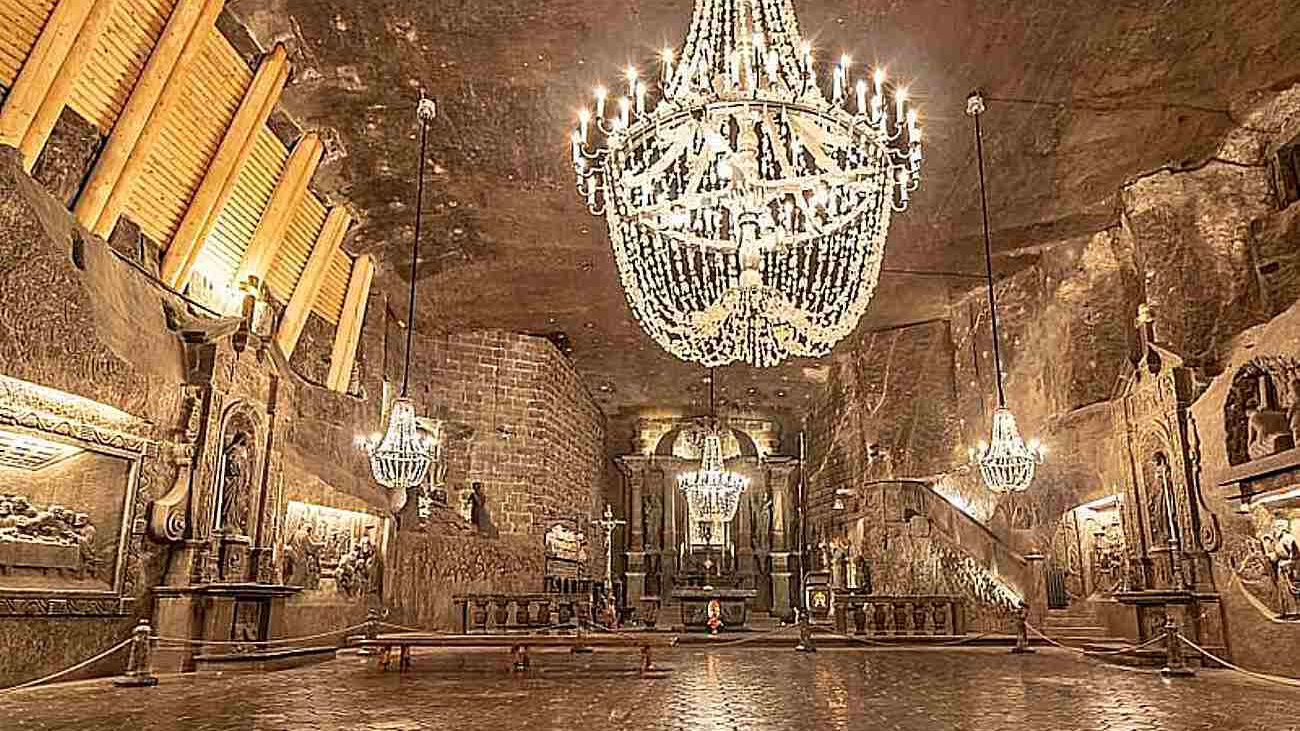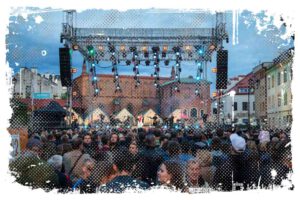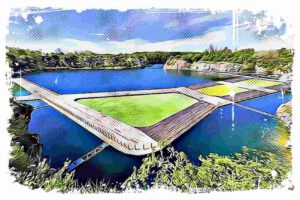If you’re looking for a one-of-a-kind experience, let me tell you about a hidden treasure deep underground in Poland. Located over a hundred meters below the surface in the former „Wieliczka” Salt Mine, you’ll find a truly unique temple and art gallery – the Chapel of St. Kinga.

This remarkable chapel attracts not only thrill-seeking tourists but also couples who fall in love with its enchanting atmosphere and choose to hold their weddings there.
Make sure you also read this article I wrote: A Tour of Poland’s UNESCO Sites: Wieliczka and Bochnia Royal Salt Mines
Unveiling the Secrets of St. Kinga’s Chapel
Nestled 101 meters underground in the „Wieliczka” Salt Mine, the Chapel of St. Kinga, the patron saint of salt miners, holds the title of the world’s largest underground temple. Although it may appear somewhat dim at first glance, I can tell you that it’s anything but gloomy. The chapel is illuminated by stunning chandeliers crafted from salt crystals, casting a warm glow over the impressive chamber that spans more than 54 meters in length, 12 meters in height, and 18 meters in width.
↳ Make sure to read my guide to the most amazing places to stay in Kraków:
How to Find Best Place to Stay in Krakow Old Town – Your Guide
An Underground Sanctuary Open to All
If you ever find yourself in Poland and want to experience the uniquenes of this subterranean chapel, you’ll be happy to know that St. Kinga’s Chapel welcomes visitors for Sunday masses and special occasions like Midnight Mass. Though it was once part of the operational mine in the 1890s, the chapel has been astonishing visitors with its uniqueness for over a century. It’s no surprise, given that its interior is essentially an art gallery filled with incredible works crafted by skilled miner-sculptors like Antoni Wyrodek and brothers Józef and Tomasz Markowski.

It’s worth mentioning that the creation of the chapel’s interior took nearly 70 years, with the most recent sculptures, including a statue of Saint John Paul II, completed at the turn of the 20th and 21st centuries. The driving forces behind the chapel’s design and construction were the miner-sculptors led by Józef and Tomasz Markowski and Antoni Wyrodek. So, if you want to witness a true marvel of art and devotion, don’t miss the chance to visit this extraordinary underground sanctuary.
The Three-Part Main Altar is a Masterpiece
If you ever have the chance to visit the Chapel of St. Kinga, make sure to pay close attention to the main altar, skillfully crafted by Józef Markowski. As the centerpiece of the chapel’s decor, the three-part altar initially featured an oil painting by Ferdynand Olesiński, a student of the renowned Jan Matejko. The painting depicted St. Kinga receiving a ring extracted from a lump of salt by a miner. In 1914, a salt-carved statue of St. Kinga by Józef Markowski was added, along with halite crystal decorations adorning the walls behind it.
Since 1994, the niche of the altar table has housed the relics of St. Kinga, with the space behind the sculpture embellished by mineral rock salt crystals, also known as halite. Flanking the main altar, you’ll find sculptures of saints St. Joseph (patron saint of carpenters and miners) and St. Clement (patron of miners and the Wieliczka parish), nestled between pairs of columns. The impressive pulpit, complete with a base depicting Wawel Hill and a dragon, was also crafted by Józef Markowski, as were the two side altars – the Heart of Jesus and the Heart of the Mother of God.
In the presbytery, you’ll find a papal cross representing the four salt mines in Poland – Wieliczka, Bochnia, Kłodawa, and Sieroszowice.
A Stunning Bas-Relief – „The Last Supper”
While exploring St. Kinga’s Chapel, you’ll also encounter a breathtaking bas-relief inspired by Leonardo da Vinci’s „The Last Supper”. Created by miner-sculptor Antoni Wyrodek, who honed his skills at the State School of Decorative Arts and Artistic Industry in Krakow, this work is a must-see.

I think it’s important to mention that the chapel walls also feature other exquisite bas-reliefs depicting events from the Holy Bible. These include The Wedding at Cana of Galilee, The Flight to Egypt, Christ Teaching in the Temple, The Road to Bethlehem, Doubting Thomas, The Massacre of the Innocents, and Herod’s Judgment. While not all of these masterpieces were crafted by Wyrodek, the final two were created by Tomasz Markowski, Józef’s younger brother, who contributed to the chapel’s interior between 1920 and 1927. Tomasz is also the artist behind three figures of Mary from the Resurrection Chapel and a small bas-relief portraying St. Kinga with a miner.
I also recommend that you read this article, from which you can learn more about how healthy the salt is to our system: Salt Therapy: The Health Benefits of Wieliczka Salt Mine Spa
A Tribute to St. Kinga – Relics and Artwork
Tomasz Markowski, the talented artist responsible for the chapel’s most important feature, the three-part altar, also crafted the side figures of St. Joseph and St. Clement (the patron saint of miners and the Wieliczka parish), as well as St. Kinga. In 1994, St. Kinga’s relics were placd in the niche of the altar table. Tomasz Markowski’s other works in the chapel include the pulpit, which features a depiction of Wawel and its defensive walls and hill, side altars, bas-reliefs „The Judgment of Herod” and „The Massacre of the Innocents,” and the statue of Our Lady of Lourdes.
Another miner-artist, Antoni Wyrodek, contributed to the chapel’s beauty by creating a salt balustrade that marks the border of the presbytery and a salt floor. Wyrodek also focused on New Testament events for his bas-reliefs, such as the Flight to Egypt and the Wedding at Cana of Galilee. Drawing inspiration from Leonardo da Vinci’s fresco, Wyrodek crafted The Last Supper bas-relief. The chapel’s decoration contains numerous other scenes from the Holy Scriptures.
The Enchanting Tale of St. Kinga’s Ring
Let me tell you an intriguing story about St. Kinga. Long ago, Prince Bolesław the Chaste, who reigned at Wawel, proposed to the Hungarian princess Kinga and presented her with a stunning engagement ring. Instead of gold or precious stones as dowry, Kinga requested salt to gift her future subjects.
To fulfill her wish, Kinga’s father granted her a mine in the region of Maramures (present-day Romania). But the princess wondered, „How can I move the entire mine to Poland?” After some thought, she tossed her engagement ring into the mine shaft.
When Kinga arrived in Poland, she and Bolesław discovered a lump of salt near Kraków, from which her engagement ring emerged. The ring Kinga had thrown into the Maramures mine brought valuable salt to the Polish lands. From that moment on, the Wieliczka Mine became renowned for its abundant salt deposits.
A Salt Tribute to John Paul II and More
While exploring the chapel, you’ll also come across some other remarkable sights. A keen eye will spot the Bethlehem nativity scene on the right wall, crafted by Mieczysław Kluzek. In the presbytery, you’ll find the papal cross, symbolizing all four salt mines in Poland (Wieliczka, Bochnia, Sieroszowice, Kłodawa). Interestingly, various salts were used in its creation. As a special tribute, a salt statue of John Paul II was sculpted by Stanislaus Anioł and his assistants in 1999. This unique figure is the world’s only salt sculpture of a pope.
A Unique Nativity Scene in Salt
The right wall of St. Kinga’s Chapel features a captivating nativity scene set in Bethlehem, masterfully created by Mieczysław Kluzek. Though the original wooden figurines, crafted by Józef Markowski, were replaced by Kluzek’s salt renditions after World War II, the scene remains a stunning display of artistry.
St. Kinga’s Chapel is undoubtedly the most recognizable chamber on the Wieliczka Mine’s Tourist Route, and it continues to serve as a sacred space. Here, you can attend Sunday masses, witness weddings, and even enjoy underground shepherdesses. From time to time, the chapel hosts chamber music concerts featuring classical pieces. It’s a truly one-of-a-kind experience you won’t want to miss.
References
- https://www.trasadlabobasa.pl/tab/legenda/legenda_o_pierscieniu_sw.kingi_kopalnia_soli_wieliczka/1
- https://muzeum.wieliczka.pl/kopalnia-soli
- https://pl.wikipedia.org/wiki/%C5%9Awi%C4%99ta_Kinga



